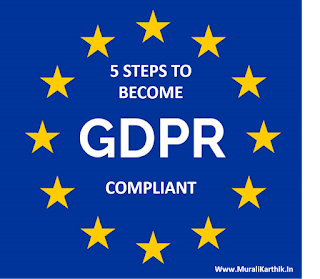What is GDPR?
GDPR has been the buzzword for all companies, online firms, digital marketing agencies and last but not the least bloggers as well. GDPR stands for General Data Protection Regulation. With a lot of data thefts, illegal usage of data tracking and other privacy related issues in the past few months, European Union has enforced strict rules for all websites/blogs/sites. This includes open disclaimers on storing cookies, storing email id/name information and the general privacy policy rules.
You might have already got 20+ emails from every single website that you have signed up to.
What happens if you don’t comply?
If you don’t ensure your blog/website is not compliant, the EU might send out a warning letter to quickly fix the issues. This will be followed by a heavy penalty/fine on your site if you are still non-compliant (4% of a company’s annual global revenue OR €20 million (whichever is greater))
You’d probably be asking : I’m just a blogger with probably a few people visiting from the European countries. Should I still go ahead and do these steps . The answer is a resounding YES !
Who are these rules applicable to ?
If you are a blogger with a WordPress site or have a company website or even an online service site or rather do business online storing customers information, you have to make your site GDPR Compliant at the earliest. Though you may have a US / India / any country site , you still have the possibility of an European visitor coming to your site through some means. Hence it’s safer to be compliant than getting caught later
Thankfully Google’s Blogspot hosted sites can sigh a relief as Google has internally done all the steps to make sure the privacy policies are updated and relevant disclaimers are present in the website. But there are a few things you may still want to do as a blog owner in Blogspot. This is explained by Shrinidhi in his blog.
Steps to become GDPR Compliant
1. Update WordPress
Update WordPress (after logging to your WP-Admin page) and ensure you have the latest version.
It’s the second option, right below Home button in the left hand side
2. a. Install “WP GDPR COMPLIANCE” Plugin in your Plugins option in the dashboard
Or manually download it from here : https://wordpress.org/plugins/wp-gdpr-compliance/
In Settings of WP GDPR COMPLIANCE Plugin, Under Integration Enable WordPress Comments and Save Changes.
All the data shown above will be stored by [Site Name] on [Site URL]. At any point of time, you can contact us and select the data you wish to anonymise or delete so it cannot be linked to your email address any longer. When your data is anonymised or deleted, you will receive an email confirmation. We also use cookies and/or similar technologies to analyse customer behaviour, administer the website, track users’ movements, and to collect information about users. This is done in order to personalise and enhance your experience with us.
4. Newsletter Subscription
If you have a newsletter subscription / popups etc, you should again copy the text in point 3 and paste it in that too at the bottom of your newsletter as a disclaimer
5. Privacy Policy Page
You need to have a separate “Privacy Policy” Page for your blog and ensure that page link is present in your homepage (in the footer or in the sidebar or as a menu link)
Go to Pages – > New Page.
Download this document and paste it ( Or you can use any other privacy policy document from any other sources)
https://docs.google.com/document/d/1ZrnLONGtWTMaQpRsjP56Qo_vu2A0IgFm-ir2us5ZM4c/edit?usp=sharing
Replace the [Site Name] at 2 places mentioned with your own website name and your email address mentioned as [Your Email Address here].
You can see how I have done the same in my travel blog, An Asian Traveller and see the Privacy Policy page menu option.
Well , that’s it. .These steps are for blogs and websites with just a comment box/ subscribe page and a newsletter and not intended for professional companies who stores financial transaction information of customers and other business related info.
Do let me know in comments, if you found it useful or have any further questions on the same.
